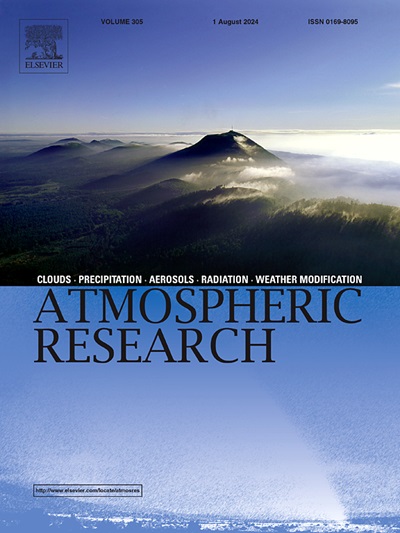The contribution of Arabian Sea warming to decreasing summer precipitation in the northern Greater Mekong Subregion
IF 4.5
2区 地球科学
Q1 METEOROLOGY & ATMOSPHERIC SCIENCES
引用次数: 0
Abstract
The Greater Mekong Subregion (GMS) is one of the world's most important agricultural regions. Over recent decades, the declining trend in precipitation has caused more frequent droughts over the northern plateau of the GMS, and this has led to a significant reduction in agricultural productivity. These drought events can also affect agriculture within the middle and lower parts of the Mekong River basin. To reveal the main causes of the decline in precipitation, this study investigates interdecadal variations in summer precipitation over the northern GMS during 1979–2022. Results indicate that summer conditions over the northern GMS entered a relatively dry period after the late 1990s. The interdecadal decrease in summer precipitation is closely associated with the warming of the northern Arabian Sea (AS), which induces a cyclonic anomaly that enhances local precipitation and associated diabatic heating. The anomalous diabatic heating induces a downstream Rossby wave train that intensifies the circumglobal teleconnection (CGT) pattern and causes the South Asian high (SAH) to extend farther southeastwards. The southeastward-displaced SAH induces easterly anomalies over the northern Bay of Bengal (BOB) that weaken the Indian summer monsoon (ISM) southwesterly flows and reduce moisture transport from the northern BOB to the northern GMS. The southeastward displacement of the SAH also causes anomalous descent over the northern GMS. Both conditions result in reduced precipitation over the northern GMS. Numerical experiments substantiate the proposed modulating role of AS warming in the interdecadal decrease in summer precipitation over the northern GMS.
阿拉伯海变暖对大湄公河次区域北部夏季降水量减少的影响
大湄公河次区域(GMS)是世界上最重要的农业区之一。近几十年来,由于降水量呈下降趋势,大湄公河次区域北部高原的干旱更加频繁,导致农业生产率显著下降。这些干旱事件也会影响湄公河流域中下游地区的农业。为了揭示降水量下降的主要原因,本研究调查了 1979-2022 年间大湄公河次区域北部夏季降水量的年代际变化。研究结果表明,自 20 世纪 90 年代末以来,大湄公河流域北部的夏季气候进入了一个相对干旱的时期。夏季降水量的年代际减少与阿拉伯海(AS)北部的变暖密切相关,它引起了气旋异常,从而增强了局地降水量和相关的二重加热。异常的二重加热诱发了下游的罗斯比波列,从而加强了环全球遥联系(CGT)模式,并导致南亚高纬度(SAH)向东南方向延伸得更远。向东南位移的南亚高气压在孟加拉湾(BOB)北部上空引起偏东异常,削弱了印度夏季季风(ISM)的西南气流,减少了从孟加拉湾北部向大湄公河次区域北部的水汽输送。SAH 的东南位移也导致 GMS 北部出现异常下降。这两种情况都导致 GMS 北部降水量减少。数值实验证实了所提出的 AS 变暖和 GMS 北部夏季降水量跨年代减少的调节作用。
本文章由计算机程序翻译,如有差异,请以英文原文为准。
求助全文
约1分钟内获得全文
求助全文
来源期刊

Atmospheric Research
地学-气象与大气科学
CiteScore
9.40
自引率
10.90%
发文量
460
审稿时长
47 days
期刊介绍:
The journal publishes scientific papers (research papers, review articles, letters and notes) dealing with the part of the atmosphere where meteorological events occur. Attention is given to all processes extending from the earth surface to the tropopause, but special emphasis continues to be devoted to the physics of clouds, mesoscale meteorology and air pollution, i.e. atmospheric aerosols; microphysical processes; cloud dynamics and thermodynamics; numerical simulation, climatology, climate change and weather modification.
 求助内容:
求助内容: 应助结果提醒方式:
应助结果提醒方式:


